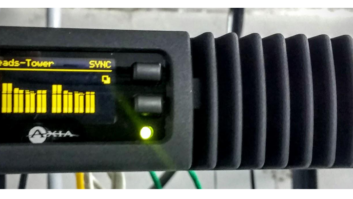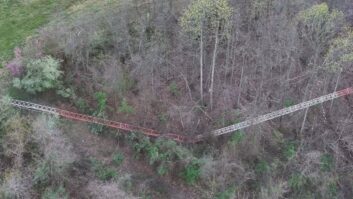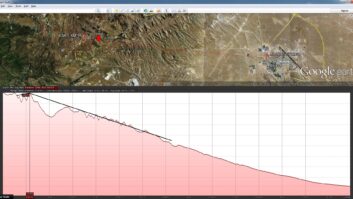GREENVILLE, Miss. — In two small Mississippi towns — Cleveland and Greenville — my radio stations needed new STL systems. We already had traditional 950 MHz composite STLs from studio to transmitter site in each town. However, we were adding additional transmitters at both transmitter sites and had to come up with more STL capacity. Being small-town stations, our budget is small, so we had to try something inexpensive.

We’ve seen quite a few IP radios come to the market lately. Available in both licensed and unlicensed bands, prices start under $100. They advertise data rates of about 150 Mbps for the lower-cost systems, and upwards of 1 Gbps for the more expensive IP radio systems.
We know these IP radios can carry “coded” or “bitrate reduced” IP audio with little trouble. Wanting to keep expenses low, my goal was to get Axia Livewire+ IP audio from studio to transmitter. That way no hardware codecs would be needed; we would need only to place an Axia xNode at the transmitter site, extending our Livewire network to there via IP radios.
RURAL PATH
After some office testing, I confirmed that inexpensive IP radios can transport Livewire audio streams, including the clocking required to slave the Axia xNode at the transmitter site. This extra research into the best configuration of the IP radios has paid off in our avoiding the purchase of numerous hardware codecs, and getting perfect, linear audio delivered right to the transmitter sites.
Under conditions involving a clear microwave RF path, we proved that even very inexpensive IP radios can handle the “Near Perfect” requirements for Livewire AoIP networking. It has also been tested with four Livewire standard streams in each direction and found to work fine as well.
The IP radios used — Ubiquiti NB-5G22 NanoBridge M5 — were purchased for under $100 each. Indeed the high-quality, outdoor-rated, shielded CAT-5e cable, shielded connectors, and CAT-5e surge suppressors cost nearly as much as the IP radios. The latter were so inexpensive that an additional pair was purchased for off-the-shelf backup.
MULTISTREAM
These IP radios are now carrying two Axia Livewire standard streams in each direction. At the far end (transmitter site) only an Axia xNode is there to convert the linear audio program streams into analog audio for two stations’ audio processors.
In another real-world case — this one in Greenville, Miss. — reliable STL for four FM radio stations was needed from a studio in a small town of 35,000 to a new transmitter site, common to all four stations. The IP radio RF path crosses the downtown area, proceeds across a university’s agricultural experimentation complex, and looks directly through a multicarrier cell tower close to the far end (transmitter site). The RF path is just over 13 miles long.
For this STL system, we chose a full-duplex IP radio, the Ubiquiti airFiber 5. To achieve full-duplex operation, this IP radio has two antennas at each end for full-time transmit and receive. This scheme reduces packet jitter caused by receive/transmit switching, making this full-duplex IP radio system behave more like a long run of Ethernet cable.
An Axia AoIP network already exists at the studio, serving all four FM stations. As such, only one additional xNode was needed for the transmitter site. This xNode brought the entire cost for a four-station linear STL system to about $4,600, or under $1,200 per radio station.
IP RADIO CONFIGURATION
The goal of proper IP radio system configuration is to obtain reliable data transfer from end to end. For the more stringent case of “near perfect” data transfer required for linear AoIP systems like Livewire, we have the additional goals of zero packet loss and very low jitter; in other words, we also want the IP radio link to operate like a wired connection.
The radios are set to operate without automatic adjustment of parameters. Such parameters include power level, frequency, modulation mode (or scheme), and distance-based parameters such as wait-time for the next send cycle (in half-duplex IP radio systems).
Experience has shown that by setting most, if not all, “automatic” functions to a manual mode, and configuring that manual setting properly, IP radios will happily operate continuously and without trouble, as long as the RF path remains viable.
One non-intuitive parameter shown on some IP radios is the “Modulation Rate,” “Max TX Rate, Mbps,” or similar. This is referring to the modulation mode or scheme. It’s a label or code which references the data modulation scheme and maximum bitrate using that scheme in a given RF channel width. Explanation and a list of these codes and parameters is given here: https://en.wikipedia.org/wiki/IEEE_802.11n-2009.
I settled on using a modulation scheme that results in a lower overall bitrate than the units are capable of, but more robust operation.
Our smaller system — with sub-$100 IP radios — has been on-air for over a year. It’s carrying two FM stations to our transmitter site in Mound Bayou, Miss. We’ve heard no dropouts in the on-air audio.
Our larger system — using $1,000 IP radios — has been on since March 2016. We’ve watched it carefully during extremely heavy rain and have seen only about 2 dB in signal degradation. We’ve heard no off-air time, and that link is now carrying perfect, linear audio for four FM stations to a rural transmitter site in Heads, Miss.
The broadcast industry used to borrow technology from the telephony sector. Now broadcasters are using plenty of tech from the IT sector. Properly engineered it’s working quite well.
For information, contact Cam Eicher at Axia Audio in Ohio at (216) 241-7225 or visit www.axiaaudio.com.












